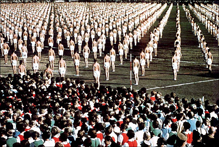
Benito Mussolini. Italy, 1930s. Postcard. Coll. Mémorial de la Shoah / CDJC.

Sporting congress at Nuremberg. Germany, 1930s. Photography: Hugo Jaeger. ©. D.R.
Book our events online
The sport
to the test of totalitarian regimes
“Believe, obey, fight”: Sport in Fascist Italy
Fascism used sport as a means of recruiting and galvanizing the masses, especially Italian young people. Mussolini wanted the youth to be dynamic, strong and loyal to their leader, in keeping with his motto “Believe, obey, fight” – which illustrates the regime's violent nature.
The example of Primo Carnera perfectly illustrates the co-opting of sporting endeavors by Italian Fascism; as World Heavyweight Champion in 1933, he became a living symbol of the regime's power. Even Il Duce himself set an example, wasting no opportunity to demonstrate his sporting prowess, or to jog while inspecting his troops.
When the Sports Charter was declared in 1928, this began the progressive dissolution of all major socialist and Catholic sports organizations. At the same time, the regime supervised young people's physical activity through a pyramid-shaped organizational structure, beginning at eight years old with the Opera nazionale balilla. Gymnastics remained compulsory until adulthood, through the Dopolavoro club (an organisation for workers created by the Fascist regime in 1925).
Anti-Semitic legislation introduced in 1938 officially excluded Jews from Italian society, and sport was no exception. The boxer Primo Lampronti was stripped of his title, and forced to end his career. Hungarian football trainer Arpad Weisz, who had helped the Inter Milan and Bologna teams reach the top of the championships, had to leave Italy and seek refuge in the Netherlands, before being deported to Auschwitz in 1942.
The « aryanization » of sport in Germany
According to Adolf Hitler, “a young German must be of slender build, as agile as a greyhound, as tough as leather and as hard as Krupp steel”. Qualities like these could only be achieved by subjecting the body to a special regime. For this reason, the Nazis very quickly expanded the nazification process to encompass physical education and sporting organizations, as well as using sport for racialist ends: that is, aryanization. More radically than in Italy, German sports were purified and placed under the control of Dresden's SA leader, Hans von Tschammer und Osten.
Sport was also made a part of young people's lives, with ten hours of physical education scheduled every week to compensate for what was deemed a “purely intellectual” education. Finally, physical exercise was compulsory for young girls and women, so that they could “provide the State and its people with healthy children”.
Furthermore, sporting organizations for workers were banned, Christian clubs were ordered to abandon all religious affiliations, and Jews were excluded from German clubs and championships. In theory, Jews were permitted to sign up with the Zionist Maccabi clubs, because they were pro-emigration, or with the Schild clubs, run by Jewish ex-soldiers who “propagated German patriotism among the Jewish youth”. In fact, these two movements encountered many obstacles, especially in obtaining specifically Jewish sports grounds, until they were permanently banned following the Kristallnacht in November 1938. The anti-Semitism of the State also applied to public sports grounds, swimming pools, and any lakes and rivers used for swimming. Jews no longer even had the right to ride a horse, on the grounds that German horses should not come into contact with Jews. Romany sportsmen were also persecuted, meaning that Sinti boxer Johann Wilhelm Trollmann, who was German champion in 1933 thanks to his famous leg-work, was stripped of his title by the Nazis. Next >>
quizz What are the « Balilla »?
A Fascist youth organization
An Italian political party
